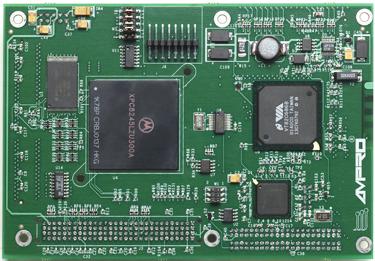Ampro’s latest EnCore adds PowerPC with Linux support
Mar 5, 2002 — by LinuxDevices Staff — from the LinuxDevices Archive — 1 viewsAmpro Computers Inc. today unveiled the latest member of its 100 x 145 mm EnCore single-board computer (SBC) module family, this one based on Motorola's 300MHz MPC8245 PowerPC processor. With the addition of PowerPC, the five members of the EnCore family now encompass three popular microprocessor architectures: PowerPC, MIPS, and… x86. The EnCore modules are supplied with board support packages that make it easy to use them in embedded systems under both Linux and VxWorks.
The new PowerPC based EnCore PP1 is based on a 300MHz MPC8245 processor with a built-in 66MHz PCI bus interface. It supports up to 512MB SODIMM SDRAM and provides 2MB Flash memory with Ampro universal bootloader/monitor software. On-board I/O includes a 10/100BaseT Ethernet controller, JTAG interface, two serial ports, two USB ports, enhanced Ultra 33/66 EIDE interface to two drives, floppy disk controller, PS/2 keyboard and mouse ports, IrDA port, an ECP/EPP bidirectional parallel port and an AC97 audio interface.

Ampro's latest EnCore module adds PowerPC to the mix
At 22 square inches of footprint, Ampro's EnCore SBC form-factor fits in a size gap between EBX (46 sq.in.) and PC/104 (14 sq.in.). Two other intermediate sized formats have also been recently advanced: JUMPtec-Adastra's ETX, which measures 3.7 x 4.5 in. (16.7 sq.in.); and the new “processor PMC” (PrPMC) standard, which is 2.9 x 6.0 in. (17.4 sq.in.) in size.
Paul Rosenfeld, Ampro's vice president of marketing, explains that the key thrust of Ampro's EnCore product line is to provide the core functions of an embedded computer in an easy-to-plug-in module without dependency on any particular microprocessor architecture and without the constraint or cost of onboard I/O interface connectors. Because, unlike Ampro's earlier PC/104 and EBX SBCs, the EnCore modules do not provide onboard connectors to I/O interfaces like serial ports, keyboard, etc., they must always be used like components, plugged into sockets on customer-supplied application-specific baseboards.
“With the addition of our MIPS and PowerPC offerings, we're bringing the benefits of off-the-shelf boards to the other 90% of designs that aren't based on embedded PCs,” said Rosenfeld.
Paul Zorfass, senior analyst with International Data Corp (IDC) noted that “by extending its EnCore line to embrace the PowerPC [architecture], in addition to x86 and MIPS, Ampro offers potential time-to-market benefits to a much wider group of interested OEMs.”
Venture Development Corp (VDC) market analyst Eric Gulliksen observed that Ampro's “Computers-on-Modules approach has the potential to really change the embedded board business. “OEMs . . . can upgrade their CPUs without having to redesign their system. They can simply plug a higher-performance EnCore module into the carrier board they already designed. Expanding the EnCore line to include the popular PowerPC-compliant microprocessors is a good move,” said Gulliksen.
“There are two things that combine to make this work,” added Rosenfeld. “One is PCI, and the other is Linux.”
Adding Intel's StrongARM or XScale to the mix might seem the next logical step in rounding out EnCore's coverage of popular processor architectures. But as Rosenfeld points out, those Intel processors lack the PCI interface needed to comply with Ampro's EnCore interface standard. However, he did not rule out a future offering which addresses that shortcoming.
What remains to be seen is whether Ampro can repeat the magic, turning its EnCore SBC form-factor into a third major non-backplane standard for the embedded market, alongside PC/104 and EBX. Ampro's EnCore is an appealing offering, but one which also has some solid competition from other would-be standards.
The EnCore PP1 CPU module will be demonstrated at the Embedded Systems Conference March 13-15 at Moscone Center in San Francisco. Beta units are available in 30 days, with production by mid-year. EnCore PP1 is priced below $300 in 1000+ quantities.
This article was originally published on LinuxDevices.com and has been donated to the open source community by QuinStreet Inc. Please visit LinuxToday.com for up-to-date news and articles about Linux and open source.